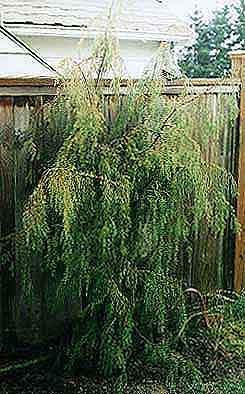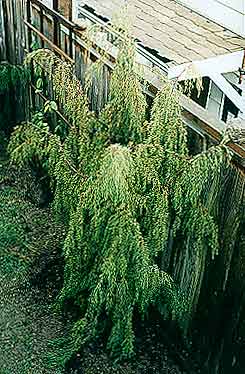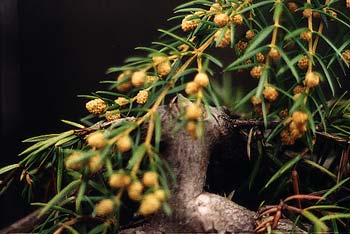 Formosa Juniper:
Formosa Juniper:
A Sasquatch in the Yard
"Who sows a field, or trains a flower,
Or plants at tree, is more than all."
-John Greenleaf Whittier
(1807-1892)
(1807-1892)
Our shaggy Juniperus formosana looks as though it is covered with thick green fur rather than needles, & we have come to think of it as the big hairy sasquatch in our garden.
Its lower limbs all weep downward, but the major upper limbs sweep upward as though the sasquatch is about to leap on anyone walking along the path & rend us into pieces. The smaller twigs of even the upreaching limbs are pendulous, as this is one of the few weeping junipers, increasing the look of a sheepdog's coat. It looks like it should even be soft as a sheepdog, but is sometimes called "Prickly Juniper" because the needles are a lot sharper than they appear & can poke like a cactus.
You can make out in the first photograph how the main trunk is a bit truncated because it long ago lost the tip of its leader. This is why the uppermost limbs have vied to become the new leader, extending the tree's height. The second photo shows the same juniper from a "bird's eye view" that we have from a high deck.
 In that second photo you can see more of how the lost tip of the trunk has induced the upper limbs to reach upward. When we first saw this specimen in a nursery, it seemed an orphan, no one buying it in over a year. The loss of the trunk's tip probably put other potential buyers off, but to Granny Artemis & me, it had far more character than other specimens we looked at. Those which had never gotten their leader accidentally "candled" looked like sagging racks of green wool lacking the upward reach of the higher limbs.
In that second photo you can see more of how the lost tip of the trunk has induced the upper limbs to reach upward. When we first saw this specimen in a nursery, it seemed an orphan, no one buying it in over a year. The loss of the trunk's tip probably put other potential buyers off, but to Granny Artemis & me, it had far more character than other specimens we looked at. Those which had never gotten their leader accidentally "candled" looked like sagging racks of green wool lacking the upward reach of the higher limbs.Personally I felt that this specimen was rendered superior by the odd "skyward reach" of its top limbs, combined with the pendulant twigs & needles so that it was simultaneously weeping downward & striving heavenward.
Since the Formosa Juniper is an Asian tree, I suppose we should be thinking of ours as a yeti rather than sasquatch, but it lives here in the Northwest now, so it's a sasquatch. It is native of the mountains of Taiwan, growing in the high wild regions of Sheipa, Taroko & Yushan National Parks, in mountain forests of mixed conifer & broadleaf trees where little black bears roam.
Its Abominable Snowman shagginess protects its brittle limb structure from savage high winds so that it can survive on very exposed rugged summits. It can survive at such elevations it is often found by itself beyond the main treeline, though in its upper range it becomes permanently stunted.
 Formosa junipers produce pea-sized oval fruit that is orange to dark red-brown, each fruit producing three oblong-triangular seeds. The fruit is shown in this May photograph. About mid-May, the slightest breeze or brush against this juniper causes it to let fly with a veritable cloudbank of white pollen.
Formosa junipers produce pea-sized oval fruit that is orange to dark red-brown, each fruit producing three oblong-triangular seeds. The fruit is shown in this May photograph. About mid-May, the slightest breeze or brush against this juniper causes it to let fly with a veritable cloudbank of white pollen.At mid mountainside, it easily reaches forty feet in height, but at sea level, in cultivation, it grows so slowly that 25 feet would be a very big one. Because it is slow-growing, it is uncommonly offered in the nursery trade, despite that it has been in cultivation in the west since 1844. Ours is a pleasing tall shrub of eight feet height, purchased rootbound in a pot, & probably already twelve years old.
The shaggy fur partially disguises the unusual shapes of its many limbs & also hides an interesting fibrous bark which exfoliates in long strips. Ours is a little bit open in the front so we can appreciate the barks & limbs, & we are training it to remain somewhat "flat" before the fence to preserve the open front that faces the path.